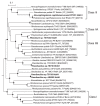Isolation and functional gene analyses of aromatic-hydrocarbon-degrading bacteria from a polychlorinated-dioxin-dechlorinating process
- PMID: 22791044
- PMCID: PMC4036015
- DOI: 10.1264/jsme2.me11283
Isolation and functional gene analyses of aromatic-hydrocarbon-degrading bacteria from a polychlorinated-dioxin-dechlorinating process
Abstract
Aerobic aromatic-hydrocarbon-degrading bacteria from a semi-anaerobic microbial microcosm that exhibited apparent complete dechlorination of polychlorinated dibenzo-p-dioxins/dibenzofurans (PCDD/Fs) were isolated through enrichment and plating culture procedures with dibenzofuran as the model substrate. By 16S rRNA gene sequence comparisons, these dibenzofuran-degrading isolates were identified as being members of the phyla Actinobacteria, Firmicutes, and Proteobacteria, among which those of the genera Paenibacillus and Rhizobium were most abundant. All of the isolates utilized naphthalene as the sole carbon and energy source and degraded dibenzofuran metabolically or co-metabolically; however, they hardly attacked monochlorinated dibenzofuran and dibenzo-p-dioxin. By PCR cloning and sequencing, genes predicted to encode aromatic-ring-hydroxylating dioxygenase (AhDO) were detected in all test isolates. Real-time quantitative PCR assays with specific primer sets detected approximately 10⁵ copies of the AhDO large subunit genes g⁻¹ wet wt in the microcosm from which the isolates were obtained. This order of the copy number corresponded to approximately 1% of the 16S rRNA gene copies from "Dehalococcoides" and its relatives present as potent dechlorinators. These results suggest that aerobic AhDO-containing bacteria co-exist and play a role in the oxidative degradation of less chlorinated and completely dechlorinated products in the PCDD/F-dechlorinating process, thereby achieving the apparent complete dechlorination of PCDD/Fs.
Figures



Similar articles
-
Bacterial Biotransformation of Pentachlorophenol and Micropollutants Formed during Its Production Process.Int J Environ Res Public Health. 2016 Nov 17;13(11):1146. doi: 10.3390/ijerph13111146. Int J Environ Res Public Health. 2016. PMID: 27869691 Free PMC article. Review.
-
Phylogenetic characterization of a polychlorinated-dioxin- dechlorinating microbial community by use of microcosm studies.Appl Environ Microbiol. 2005 Aug;71(8):4325-34. doi: 10.1128/AEM.71.8.4325-4334.2005. Appl Environ Microbiol. 2005. PMID: 16085820 Free PMC article.
-
Microbial degradation of chlorinated dioxins.Chemosphere. 2008 Apr;71(6):1005-18. doi: 10.1016/j.chemosphere.2007.10.039. Epub 2008 Feb 20. Chemosphere. 2008. PMID: 18083210 Review.
-
Bioremediation potential of soil contaminated with highly substituted polychlorinated dibenzo-p-dioxins and dibenzofurans: microcosm study and microbial community analysis.J Hazard Mater. 2013 Oct 15;261:351-61. doi: 10.1016/j.jhazmat.2013.07.039. Epub 2013 Jul 24. J Hazard Mater. 2013. PMID: 23959255
-
Characterization of Rhizobium naphthalenivorans sp. nov. with special emphasis on aromatic compound degradation and multilocus sequence analysis of housekeeping genes.J Gen Appl Microbiol. 2012;58(3):211-24. doi: 10.2323/jgam.58.211. J Gen Appl Microbiol. 2012. PMID: 22878739
Cited by
-
Cultivating yet-to-be cultivated microbes: the challenge continues.Microbes Environ. 2013;28(2):163-5. doi: 10.1264/jsme2.me2802rh. Microbes Environ. 2013. PMID: 23727826 Free PMC article. No abstract available.
-
Microbial ecology pushes frontiers in biotechnology.Microbes Environ. 2014;29(1):1-3. doi: 10.1264/jsme2.me2901rh. Microbes Environ. 2014. PMID: 24694563 Free PMC article. No abstract available.
-
Bacterial Biotransformation of Pentachlorophenol and Micropollutants Formed during Its Production Process.Int J Environ Res Public Health. 2016 Nov 17;13(11):1146. doi: 10.3390/ijerph13111146. Int J Environ Res Public Health. 2016. PMID: 27869691 Free PMC article. Review.
-
Rhizobia and their bio-partners as novel drivers for functional remediation in contaminated soils.Front Plant Sci. 2015 Feb 5;6:32. doi: 10.3389/fpls.2015.00032. eCollection 2015. Front Plant Sci. 2015. PMID: 25699064 Free PMC article. Review.
-
The challenges of studying the anaerobic microbial world.Microbes Environ. 2014;29(4):335-7. doi: 10.1264/jsme2.ME2904rh. Microbes Environ. 2014. PMID: 25743613 Free PMC article. No abstract available.
References
-
- Asturias JA, Diaz E, Timmis KN. The evolutionary relationship of biphenyl dioxygenase from Gram-positive Rhodococcus globerulus P6 to multicomponent dioxygenases from Gram-negative bacteria. Gene. 1995;156:11–18. - PubMed
-
- Batie CJ, Ballou DP, Correll CC. Phthalate dioxygenase reductase and related flavin-iron-sulfur-containing electron transferase. In: Müller F, editor. Chemistry and Biochemistry of Flavoenzymes. CRC Press; Boca Raton, Fla: 1992. pp. 543–566.
-
- Bunge M, Adrian L, Kraus A, Opel M, Lorenz WG, Andreesen JR, Görisch H, Lechner U. Reductive dehalogenation of chlorinated dioxins by an anaerobic bacterium. Nature. 2003;421:357–360. - PubMed
-
- Bunge M, Lechner U. Anaerobic reductive dehalogenation of polychlorinated dioxins. Appl Microbiol Biotechnol. 2009;84:429–444. - PubMed
Publication types
MeSH terms
Substances
Associated data
- Actions
- Actions
- Actions
- Actions
- Actions
- Actions
- Actions
- Actions
- Actions
- Actions
- Actions

